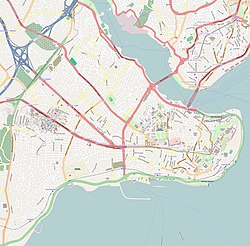Yedikule
Yedikule | |
|---|---|
Neighbourhood | |
| Coordinates: 40°59′36″N 28°55′23″E / 40.9933525°N 28.923093°E | |
| Country | |
| Province | Istanbul |
| District | Fatih |
| Time zone | GMT +2 |
| Area code | (+90) 212 |
Yedikule (English: Seven Towers) is a neighborhood of Fatih, Istanbul in Turkey. It is named after the seven-towered Yedikule Fortress, which surrounds the neighborhood. Urbanized in the 16th century, the neighborhood became a hub for industrial and agricultural activities. Yedikule has a local football team Yedikule GSK that played in the TFF Second League for a season.[1]
Marmaray passes through the neighbourhood, however Yedikule railway station is closed and the trains do not serve to the neighbourhood.
History
Urbanization of Yedikule started in 16th century, and became a major hub for industrial and agricultural activities.[2] Yedikule Walls (also known as Theodosius Walls) are also an notable historical artifact. Its tower, Yedikule Fortress, constructed between 408-450 AD, and repaired after 740 Istanbul earthquake.[3]
Ottoman period
Yedikule was known with its gardens, Yedikule Urban Gardens, which was also famous with its cabbages and lettuces and used more than 1500 years.[4] According to the guarantor books of year 1735, there were 344 gardens (including nine gardens which is established between "Surdibi" area, which stretch between Yedikule Gate and Silivri Gate); according to a map from 1835, there were 102 gardens.[4]
Yedikule (with Edirnekapı) was also became host for some establishments like slaughterhouses, soap and candle makers, and workshops.[2]
Modern times
Yedikule became highly populated after the population boom in Istanbul between 1940s-1980s; and as a result of that, the Urban Gardens and industrial areas became residential areas and some parts of Urban Gardens used for build Otoyol 1 and create waste-filling areas in 1970s. The municipality of İstanbul started a rehabilitation project for remaining parts of Urban Gardens.[5] Ekrem İmamoğlu, as the Mayor of Istanbul, stated that: "I'm ashamed from that the walls (Yedikule Walls) hasn't been toured since years." [6]
Soil and seismology
A major seismically active fault zone, the North Anatolian Fault, passes offshore from Yedikule in the Sea of Marmara.[7]
Demographics
Yedikule was including a notable non-Muslim population and schools until the recent times. There is also Greek and Armenian churches and an Armenian hospital, Yedikule Surp Pıgiç Hospital.[8] Its population is 18,879 according to 2019 census.[9]
In popular culture
Kazım Koyuncu gave a concert in Yedikule Fortress in 2004.[10] Yedikule also hosted thematic festivals such as Lettuce Feast (Turkish: Marul Bayramı) in the past.[5]
Gallery
-
The Yedikule Fortress ("Fortress of the Seven Towers") and the Golden Gate in Istanbul by Fr. Scarella c. 1685
-
Yedikule from the Marmara Sea, late 19th century
-
The Fortress in 2008
References
- ^ "Mahallî Ligin umumi bilançosu". Cumhuriyet. 16 June 1961. p. 6.
- ^ a b Akyazıcı Özkoçak, Selma (2003). "Two urban districts in early modern Istanbul: Edirnekapı and Yedikule". Urban History. 30 (1): 26–43. ISSN 0963-9268. Retrieved 9 January 2021.
- ^ Acun Özgünler, Seden; Ersen, Ahmet; Güleç, Ahmet (1 December 2010). "Yedikule Kara Surları'nda Kullanılan Erken Bizans Dönemi Harçlarının Karakterizasyonu Üzerine Bir Araştırma". Restorasyon ve Konservasyon Çalışmaları Dergisi (in Turkish) (5): 31–39. ISSN 1309-7016. Retrieved 9 January 2021.
- ^ a b Kanbak, Ayşegül (2016). "İstanbul Yedikule bostanları: Bir yerinden üretim pratiği". ISSN 2147-4877. Retrieved 9 January 2021.
{{cite journal}}: Cite journal requires|journal=(help) - ^ a b Durusoy, Elifnaz (2016). "Historic Landscape vs. Urban Commodity?: The Case of Yedikule Urban Gardens, Istanbul". MEGARON / Yıldız Technical University, Faculty of Architecture E-Journal. doi:10.5505/MEGARON.2016.48343. Retrieved 9 January 2021.
- ^ "BAŞKAN İMAMOĞLU'NDAN "TARİHİ SURLAR" YORUMU: "SURLARIN YILLARDIR GEZİLMEMESİNDEN UTANIYORUM"". www.ibb.istanbul. Retrieved 10 January 2021.
- ^ Keskinsezer, Ayhan; Beyhan, Günay; Gallajov, Javid (8 August 2019). "Investigation of the soil structure of the area between Yedikule to Sirkeci (İstanbul) using PS logging and earthquake data". Russian Journal of Earth Sciences. 19 (4): 1–12. doi:10.2205/2019ES000668. Retrieved 9 January 2021.
- ^ Kalkan, Ersin (2002). 168 yıllık sağlık abidesi: Yedikule Surp Pıgiç Hastanesi'nin tarihi yazıldı.
- ^ "YEDİKULE MAHALLESİ NÜFUSU, FATİH İSTANBUL". www.nufusune.com. Retrieved 10 January 2021.
- ^ Solomon, Thomas (2017). "Who Are the Laz? Cultural Identity and the Musical Public Sphere on the Turkish Black Sea Coast". The World of Music. 6 (2): 83–113. ISSN 0043-8774. Retrieved 10 January 2021.




